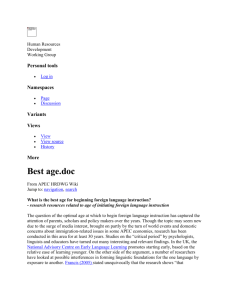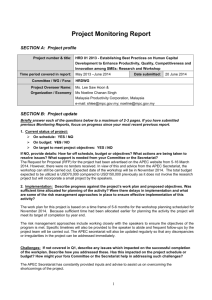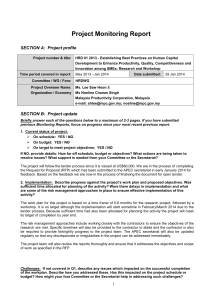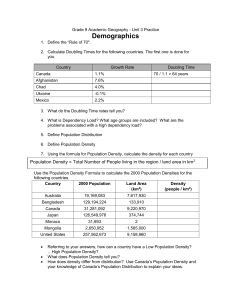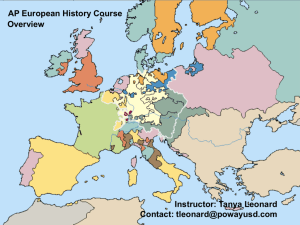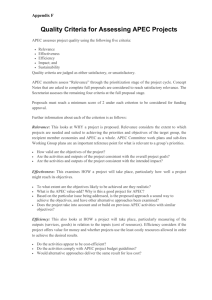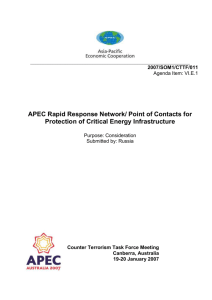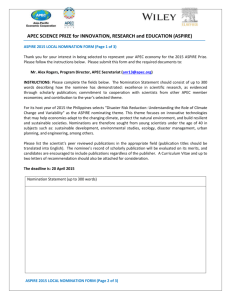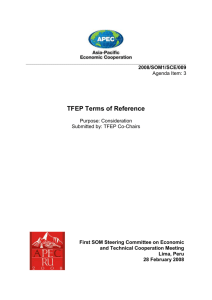PTT
advertisement
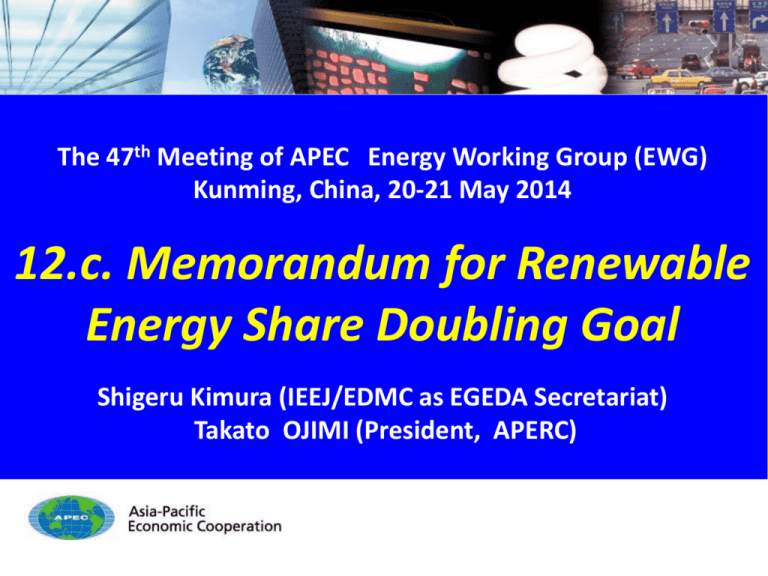
The 47th Meeting of APEC Energy Working Group (EWG) Kunming, China, 20-21 May 2014 12.c. Memorandum for Renewable Energy Share Doubling Goal Shigeru Kimura (IEEJ/EDMC as EGEDA Secretariat) Takato OJIMI (President, APERC) EWG47 12.c. RE Share Doubling Goal - 1/17 12.c. Background of the RE Share Doubling Goal • Under the Sustainable Energy for All (SE4All) Initiative, the UN has set a goal of doubling the share of renewable energy in the global September energy mix by 2030. 2011: February 2014: • At the First Senior Officials Meeting (SOM1) in China, members discussed the possibility of committing to a regional energy goal that is in line with the SE4ALL initiative. • At the Joint EGNRET and EGEDA Meeting in Hawaii, EGNRET members discussed the technical aspects of RE goal as well as technology cost goals. April 2014: • EGEDA and APERC were tasked to prepare a memorandum to facilitate the discussions on APEC Renewable Energy Share Doubling Goal at the APEC EWG 47 Meeting in Kunming, China. EWG47 12.c. RE Share Doubling Goal - 2/17 12.c. (1) Comparison of Renewable Energy (RE) Share • RE share in APEC statistics is 6% in 2010, on the other IEA is 9%. But the share of commercial renewable energy is same in both APEC and IEA. • IEA estimates non-commercial energy based on FAO ‘s survey results. Comparison of APEC & IEA (Supply, 2010) IEA data 91% 4% 5% APEC data 94% 0% 20% Non-Renewable 40% 60% RE (commercial) 4% 2% 80% 100% RE (non-commercial) Note: non-renewable: Coal, Oil, Gas, Nuclear, Electricity, Heat, Industrial Wastes commercial RE: Hydro, Wind, Geothermal, Solar, Biogas, Bioliquids etc. non-commercial RE: Primary solid biomass Source: APEC energy database, IEA EWG47 12.c. RE Share Doubling Goal - 3/17 12.c. (1) Data Submission Status in APEC Data Collection • Some member economies do not submit their RE data , especially for noncommercial products. Submission of RE data among APEC economies is inconsistent. Industrial Waste Municipal Solid Waste Liquid Biofuels Viet Nam Biogas Thailand Other Biomass Chinese Taipei Charcoal Singapore Bagasse Russia FuelWood & Woodwaste Philippines Solar Heat Peru Geothermal Heat Papua New Guinea Solar thermal Malaysia Wind Indonesia Tide,Wave, Ocean Hong Kong, China Photovoltaic China Geothermal Power Brunei Hydro Table: Data Submission of RE from APEC non-OECD economies (2010) ○ ○ ○ ○ ○ ○ ○ ○ ○ ○ ○ ○ ○ ○ ○ - ○ ○ ○ ○ ○ ○ - - ○ ○ ○ ○ ○ ○ ○ - ○ ○ - - ○ ○ - ○ ○ ○ ○ ○ ○ ○ ○ ○ - ○ ○ ○ ○ - ○ ○ ○ ○ - ○ ○ ○ - ○ ○ - ○ ○ ○ ○ - ○ ○ ○ ○ - EWG47 12.c. RE Share Doubling Goal - 4/17 12.c. (1) Comparison of RE Share in Supply and Demand • To calculate indigenous production of renewable energy, following efficiencies are applied in APEC energy balance tables. - Geothermal: 10% - Hydro and Other RE Power except biomass: 100% • Then, geothermal energy brings higher renewable share in primary supply than final consumption. This shows that renewable energy share in primary supply is not appropriate. Comparison of RE share in Supply and Demand(New Zealand) Primary Energy Supply 56% Final Consumption 38% 71% 0% Non-Renewable 20% 40% RE (commercial) 21% 60% 80% Comparison of RE share in Supply and Demand(Philippines) 6% Primary Energy Supply 8% Final Consumption 100% RE (non-commercial) 60% 24% 73% 0% Non-Renewable 20% 40% RE (commercial) 16% 8% 60% 80% 18% 100% RE (non-commercial) Note: Commercial renewable energy include electricity generated by RE energy. Source: APEC energy database (data of 2010) EWG47 12.c. RE Share Doubling Goal - 5/17 12.c. (2) Survey of Definitions of Renewable Energy (RE) • Definitions of hydro power should be harmonized to IEA and IRENA. • Standard methodology for renewable energy survey is recommended. Table: Comparison of definition of RE (excerpt) IRES Municipal w aste (renew able) Municipal w aste (non-renew ) Wood pellets Other Fuelw ood, w ood residues and by-products Other vegetal material and residues Black liquor Bagasse Hydro electricity IRENA Renew able Municipal Waste other (non-renew able) Wood and straw pellets/briquettes Fuelw ood Wood w aste IEA Municipal Waste - Renew able Municipal w aste (non-renew ) Solid biofuels excluding charcoal APEC Municipal Solid Waste FireWood & Wood w aste Rice husks Straw Other vegetal and agricultural w aste Other primary solid biomass Black liquor Bagasse Hydro Hydro-1 MW Hydro 1-10 MW Hydro 10+ MW Pumped Hydro Other Biom ass Bagasse Hydro Hydro-1 MW Hydro 1-10 MW Hydro 10+ MW Pumped hydro Hydro EWG47 12.c. RE Share Doubling Goal - 6/17 12.c. (3) Alternative Definitions Priority Geothermal Solar Wind Tidal/Wave Large Hydro Small Hydro Modern Bioenergy Traditional Biomass Waste Imported RE 3-1. Purpose of the Doubling Goal •What is the purpose of RE share doubling goal? Energy Security X Emissions Reduction Sustainable Development X X EWG47 12.c. RE Share Doubling Goal - 7/17 12.c. (3) Alternative Definitions 3-2. An Example of Alternative Definitions • From the viewpoint of sustainable development which covers not only CO2 reduction but also environmental protection, health promotion and other social values, it is possible to define “RE to be promoted by APEC”. “Sustainable RE” consists of: a) Small-scale hydro; b) Wind; c) Solar (photovoltaic and solar heat); d) Geothermal; e) Bioenergy excluding traditional firewood and charcoal for households; f) Upcoming Alternative energies that meet the sustainable criteria. EWG47 12.c. RE Share Doubling Goal - 8/17 12.c. (3) Alternative Definitions 3-2. An Example of Alternative Definitions • If the “Sustainable RE” definition is adopted, a more concrete agreement for categorizing “small-scale hydro” is needed. • EGEDA will need to collect additional data collection since hydro in APEC Energy Statistics is aggregated without any classification by scale. •EGNRET network will need to be mobilized to acquire definition, data and estimates of small-scale hydro in each economy. EWG47 12.c. RE Share Doubling Goal - 9/17 12.c. (4) Other Issues 4-1. Goal Setting Period • 2005 and 2035 is proposed for the base year and the target year to maintain consistency with the APEC Energy Intensity Reduction Goal. 4-2. Denominator in Share Calculation • Both Total Primary Energy Supply (TPES) and Total Final Energy Consumption (TFEC) are possible. • In order to avoid overestimating the role of RE when low efficiency accounting method is assumed (or conversely), it is proposed that APEC uses TFEC as a denominator in RE share calculation. EWG47 12.c. RE Share Doubling Goal - 10/17 12.c. (5) A Trial Calculation • This trial calculation makes use of 1. The IEA Energy Balance Database for 2005 data. 2. The APEC Energy Demand and Supply Outlook 5th Edition for the forecasted data. • Due to the data constraints, the “Sustainable RE” categorization here consists of: 1. All RE power generation. 2. Direct-use of RE (but excludes RE in the residential, commercial and other sector). • The denominator is the Total Final Energy Consumption (TFEC). EWG47 12.c. RE Share Doubling Goal - 11/17 12.c. (5) A Trial Calculation APEC Outlook Forecasts for Share of RE in APEC TFEC, in 2035: Examining impact of including hydro in RE Share 8000 With hydro Without hydro 7000 6000 Mtoe 5000 4000 3000 2000 1000 0 2005 Historical 2035 BAU 2035 Doubling Share 2005 Historical 2035 BAU 2035 Doubling Share 2.0% 4.4% 4.1% 4.9% 7.8% 9.8% Others Sustainable RE (exc traditional biomass) EWG47 12.c. RE Share Doubling Goal - 12/17 12.c. Appendix: Comparing APEC and IEA Forecasts Projections Base Year Scenarios APEC Energy Demand and Supply Outlook, 5th Edition 2009 IEA data A business-as-usual (BAU) scenario that covers all sectors and is based on the continuation of existing policies. IEA World Energy Outlook 2013 2011 IEA data Current Policies Scenario (CPS): similar to APEC’s BAU. New Policies Scenario (NPS): implementation of announced policies that have not been enacted yet. 450 Scenario (450): to set the energy system on track to have a 50% chance of keeping to 2℃ the long-term increase in average global temperature. EWG47 12.c. RE Share Doubling Goal - 13/17 12.c. Appendix: Comparing APEC and IEA Forecasts WEO 2013 Forecasts for Global RE Share in 2035, under 3 Scenarios 14000 12000 Mtoe 10000 8000 6000 4000 2000 0 2011 2035 CPS 2035 NPS 2035 450 17.0% 17.5% 20.4% 29.0% Fossil Fuels + Nuclear Hydro+Bioenergy+Other RE (inc traditional biomass) * Disaggregated data by economy not available * Data for traditional biomass not available EWG47 12.c. RE Share Doubling Goal - 14/17 12.c. Appendix: Comparing APEC and IEA Forecasts •Based on available IEA data, comparison can be made for 10 out of 21 APEC economies (> 85% of APEC TFEC). The following table includes hydropower as RE. * The ten economies are Canada, Chile, Mexico, USA, Australia, Japan, Korea, New Zealand, Russia and China. EWG47 12.c. RE Share Doubling Goal - 15/17 12.d. Appendix: Comparing APEC and IEA Forecasts • The following table does not include hydropower as RE. * The ten economies are Canada, Chile, Mexico, USA, Australia, Japan, Korea, New Zealand, Russia and China. EWG47 12.c. RE Share Doubling Goal - 16/17 12.c. Appendix: Comparing APEC and IEA Forecasts • There is small difference between APEC BAU and IEA CPS forecasts in 2035. • Under the APEC BAU and IEA CPS scenarios, and even under the IEA NPS Scenario, if traditional biomass is included, it would be impossible for APEC economies to achieve the aim to double RE share in TFEC basis by 2035, using 2005 as base year. • Only under IEA 450 scenario will this aim be attained, but this entails massive reduction of energy consumption as well as large increase of RE. EWG47 12.c. RE Share Doubling Goal - 17/17
